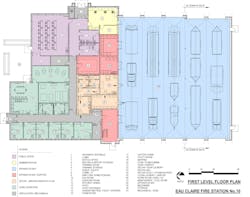The fire stations entered in the 2018 Station Design Awards (SDA) have evolved significantly from four years ago when the concept of fire station “hot zones” was first introduced to reduce carcinogens from living quarters in fire stations. This year, a number of other trends were also spotted and worth highlighting.
Health and safety
The 2018 entries saw increases in firefighter health and safety, from secured parking and key code access to airlock passage ways between apparatus bays and living areas. There were also first-floor fitness rooms “storefront” windows for safe monitoring as well as sauna units and steam showers for detoxification after intense fires.
A number of SDA entries featured decontamination areas designed within the apparatus bays; however, several located on the far side of the apparatus bay required crossing the “red” areas to enter the “green” living quarters. The SDA judges recommended the Eau Claire, WI, Fire Station 10’s decon layout for its design flow, which involved entering from the apparatus bay to the decon room, proceeding to gear laundry and hallway for access to two decon toilet/steam showers before exiting the clean laundry area to the living areas.
Energy efficiency
Energy efficiency took many forms in entries this year. Notably, more stations featured an increase in the use of natural lighting, but only one—the Career 1 Gold winner, Salt Lake City, UT, Fire Station 14—is Net Zero Energy (NZE). According to the Department of Energy, an NZE building produces enough renewable energy to meet is own annual energy consumption requirements, thereby reducing the use of nonrenewable energy in the building sector.
An ultra-modern design, Station 14 features an expanse of triple-glazed, high-efficiency windows around the exterior of the building, and the design team met the city’s requirement to achieve NZE within the project. Within the first five months of operation, the Salt Lake City fire station is producing more energy than it consumes.
On another note, Salt Lake City Station 14 and Albany, OR, Fire Station 11 each mentioned designated spaces to allow for quiet relaxation or mental well-being. We think the fire service emphasis on behavioral health will see the value and raise awareness of quiet areas.
Going vertical
Fire poles appear to be making a comeback as fire departments opt to go vertical with two and three-story buildings, often the result of site restrictions. The two-story Gainesville, FL, Fire Station #1 [picture] has a three-story training tower and three fire poles. Engine Company Number 16 in Washington, DC, repaired the original fire poles and safety cages in its historic building.
The Russellville, AR, Central Fire Station, 70 miles northwest of Little Rock, is a three-story building on a zero lot line site. The building’s programs are divided by floors and connected through stairs, an elevator and fire poles. Due to the limited site, a large roof deck was designed to provide an outdoor living space.
Funding focus
Finding funds for a new station sometimes requires creative thinking. In Texas, BASF Chemical Corporation offered to donate the land for Clute Fire & EMS’ new Station No. 1 on the condition that BASF would occasionally use the station’s training room. Designed with five zones, the first zone is for public access and BASF training. The remaining four zones include security and privacy for the staff.
The Municipality of Bethel Park, PA, stepped in to help a desperate Bethel Park Volunteer Fire Company build a new facility. The municipality amended its Municipal Charter for the ownership, repair, construction and lifetime maintenance of the three fire stations. Firefighters respond, train and buy equipment. As a result, recruitment is up, and Bethel’s new 75-year lifespan structure is a win-win for the department and community.
The Niagara Engine Company No. 6 Fire Station in Schoharie, NY, was offered FEMA funding for a new “in-kind” fire station, with no “betterments” not mandated by law or code. With hard work and laborious documentation, the engine company convinced FEMA to approve a fully modern station. As a special bonus, new kitchen equipment was donated by a local restaurant.
Miscellaneous trends
Most entries included fire sprinklers. One unique feature in the Volunteer/Combination Bronze Award winner, Klein Fire Station No. 8, Spring, TX, is protected by solenoid shut-off valves at the gas grill and stove. The valves are tied into the alerting system, ensuring that all open flames are extinguished when the staff leaves the station.
This year’s entries included two volunteer/combination stations—Clute Fire & EMS Station No. 1 and Bainbridge Island, WA, Fire Station 21—with helipads installed on site for life-flight patients. Bainbridge provides air ambulance services from its station.
Additionally, designated emergency operation centers (EOC) and walk-in first aid rooms appeared in more stations this year.
Multi-purpose facilities
Without question, the costs for a new fire station have dramatically increased in the past 15 years. But these buildings are not just fire stations; they are multi-purpose facilities that house high-tech apparatus and equipment, as well as professionally trained men and women to respond to a wide variety of emergencies, day or night. The job has gotten more complicated and so has its structure.
About the Author
Janet A. Wilmoth
Special Projects Director
Janet Wilmoth grew up in a family of firefighters in a suburb of Chicago. Wilmoth, who is owner of Wilmoth Associates, worked with Fire Chief magazine for 27 years until it closed in 2013. She currently is the project director for Firehouse, overseeing the Station Design Conference.
![The two-story Gainesville, FL, Fire Station #1 [picture] has a three-story training tower and three fire poles. The two-story Gainesville, FL, Fire Station #1 [picture] has a three-story training tower and three fire poles.](https://img.firehouse.com/files/base/cygnus/fhc/image/2018/11/Gainesville_Fire_Station_1___Exterior_1.5bf45ab47628a.png?auto=format,compress&fit=fill&fill=blur&q=45?w=250&width=250)

